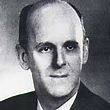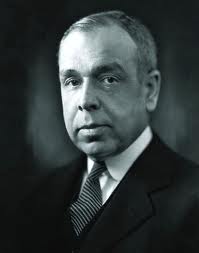Hobart Mowrer
Born in 1907, Hobart grew up in Unionville, Missouri, and suffered from major depression due to the death of his father when Hobart was Thirteen (Lindzey).
But he endured and graduated from high school, entering the University of Missouri in 1925. He majored in Psychology and studied under a behaviorist from Germany by the name of Meyer. His senior year, Hobart was expelled for distributing a phony questionnaire that asked students about their sexual habits. He was later awarded a degree and entered Johns Hopkins, studying under Dunlap. He completed his Doctorate in Spatial Orientation in 1932 and went on to get married to Willie Mae (Lindzey).
It was difficult to find employment during the Great Depression, but Hobart finally acquired a fellowship at Yale researching Learning. After two years, he was hired by the Human Relations department to teach the integration of Psychology and Society. Some years later, he began to experiment with Shock Therapy to prove that anxiety is anticipatory. In 1940, Hobart took on the position of Assistant Professor at Harvard. While there, he developed the Harvard Department of Social Relations. He also struggled with his depression again, causing him to wonder if the Freudian analysis he had experienced were faulty. When the war started, Hobart became a Psychologist for what would become the CIA. His experience allowed him to judge how well soldiers reacted to stress. In 1948, they moved to the University of Illinois to again research Learning. In 1953, he suffered his worst bout of depression and was forced to be hospitalized, forgoing the presidency of the American Psychological Association (Lindzey).
After several years, he was forced to resort to a clinical drug to beat the depression. It was at this time that Hobart read Magnificent Obsession by Douglas and it changed his official approach to Psychology. After some convincing, Hobart attained funds from a branch of Eli Lilly to start a program to teach his techniques on counseling in groups. It was here that group therapy was born and Hobart encouraged neurotic individuals to find their cure in the confessing of deception (Lindzey).
Hobart finally “hung up” his pen and pad in 1975. His wife died in 1979 due to health problems. This led him to commit suicide in 1982. He was 75 (Lindzey).
J. Gresham Machen
Earlier this week I was listening to a file about the life of Horatio Spafford and it reminded me of another man who made a large difference in American culture.
John Gresham Machen was born in Baltimore, Maryland on July 28, 1881 to Arthur Machen and Mary Gresham. He was raised to appreciate the value of Scripture as well as the Catechisms and the foreign languages, such as Latin and Greek. John attended Johns Hopkins University for his undergraduate, as well as staying an additional year to study the Classics. He then transferred to the University of Chicago to study Banking. However, the interest did not hold, and John was soon at Princeton University and attained his second bachelor’s degree, this time in philosophy. His time here was well spent, developing relationships with the staff such as Wilson and Armstrong. In 1905, he was given the opportunity to study in Germany at Marburg and Gottingen. This was also the time that he discovered his love for the mountains. While there, he met a professor named Herrmann who further contributed to his thoughts on intellectual faith, which he would later write about.
Upon his return to the States John was offered the position of Greek Assistant to Armstrong at Princeton, which he accepted. Machen was able to build quite a relationship with the students at this time because he lived in the same building as they did. In 1909 there was a student uprising, the second in 50 years, that claimed dissatisfaction with the teaching at Princeton. Among other things, they complained that certain teachers were too “dull” and “impractical.” The protest ended rather peaceably, though it was noted that no one had complained about Machens teaching.
Over the next several years he was able to work on manuscripts pertaining to New Testament history, times and figures, which he had quite a passion for. This would eventually culminate in his other NT work, The Origin of Paul’s Religion (1921). This book is one of the few I would like to focus on, though before he wrote it, John was involved in several life altering things. First, he was ordained by Presbyterians, which allowed him to preach in hundreds of churches and schools until the time of his death. Second, he was promoted from Greek Assistant to Assistant Professor when Armstrong became President of Princeton. Third and last, he served with the YMCA in World War 1 from 1918 to 1919. During this war time he was able to pass out his own works, which then numbered two, as well as many others’ works to the traveling soldiers. His days were grueling, often officially lasting 10-12 hours, not including his paperwork.
After the war ended, Machen again took up his post at Princeton and was soon planning lectures as well as writing his first book. The lectures were for Union Theological Seminary in Virginia as a favor to W.W. Moore. They were connected with his first work, The Origin of Paul’s Religion, in content; they had a great deal to do with New Testament theology. This book was published when the most popular, and most recent view of the source of Paul’s religion was that Paul had derived his Christ from certain Greco-Roman narratives of deities. The man who wrote the work that inspired this view was Wilhelm Bousset. Machen, however, fought against this view with the lectures and book, as well as other views that claimed Paul received his inspiration from culture. He proved them inaccurate by comparing them to historical evidence and then each other. Finally, he moved that the only logical, reasonable answer to the source of Paul’s fanaticism was the historical Jesus, who was God. This claim came at a time when the whole scriptures’ accuracy was being questioned, especially by Strauss of the University of Tubingen in Germany. And though unpopular, it did successfully put a face on the front opposing that of the higher critics.
The very next year, 1922, a famous preacher, Harry Fosdick, preached a message entitled “Shall the Fundamentalists Win?” His main premise was that Christianity needed to be a religion that did not use some biblical facts as a crutch for faith. Soon thereafter, a second sermon, this one preached by Clarence Macartney who was Pastor of Arch Street Presbyterian Church in Philadelphia, insisted that Fosdick was wrong and that all of scripture was necessary for true faith. Though this was a good return, Machen felt like a more permanent response was needed. In 1923, he published his sixth work, Christianity and Liberalism. It seems like God had set aside Machen for this very purpose since he had been exposed to this heresy with Herrmann in Germany. And then when he was struggling with true faith and spiritual experience, God gave him time and godly counselors (his mother among them). That way when Fosdick came out with his theory that was actually backed by a number of people, Machen was mentally and spiritually prepared to give a rebuttal. And give a rebuttal he did.
Machen would continue to fight the deteriorating effects of liberalism for the rest of his life, which lasted until 1937 when he died of pneumonia in North Dakota. But the 14 years he had left would be filled with many, many sermons as well as several more published works including, What is Faith? and The Virgin Birth of Christ. Machen also had to leave Princeton due to a liberal getting hold of it, though he responded with forming his own seminary, Westminster Theological Seminary in Philadelphia. He was also forced to pull out of the Board of Foreign Missions due to a liberal, and again founded another body, the Independent Board of Foreign Missions. One can see by these actions that John G. Machen was a man of God’s word, as well as understanding it and doing all he could to stand up for what it said, both spiritually and socially whether he was alone or no.


